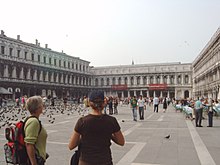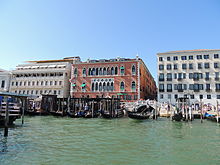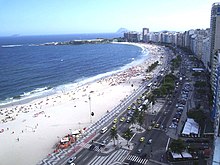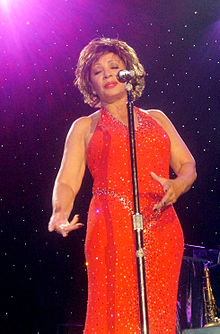James Bond 007 - Moonraker - Top Secret
James Bond 007 - Moonraker - Top Secret (original title: Moonraker ), was released in 1979 and is the eleventh film in the James Bond series and the fourth with Roger Moore in the lead role.
The disappearance of a space glider leads the secret agent around the world and even into space on Her Majesty's behalf. Together with CIA agent Holly Goodhead , he finally saves the world from annihilation.
The film was the first James Bond co-production between the British and French United Artists studios. It opened in Austrian cinemas on July 26, 1979 and in German cinemas on August 31, 1979.
action
During the transport of the space glider Moonraker on the back of a Boeing 747 , the space glider is hijacked and the transport plane is destroyed. Bond is given the task of looking for the causes of the kidnapping in the production facilities of the shuttle builder Drax Industries in California . There he meets NASA scientist Dr. Holly Goodhead, who shows him shuttle production and parts of astronaut training. He escapes an assassination attempt staged by Drax's bodyguard Chang in the gravity simulator and, during a nightly visit to Drax's office, discovers evidence of a glass factory in Venice . The next day he escapes a fictitious hunting accident.
When he arrived in Venice, he was astonished to meet Holly Goodhead again, who pretended to give a lecture at ESA and brusquely refused to admit the bonds. While driving in his gondola , he is pursued through the canals of Venice, whereupon, after a wild hunt, he turns the gondola into a hovercraft at the push of a button and can escape via St. Mark's Square .
At night, Bond breaks into the glass-blowing workshop and finds a secret laboratory in which two employees fill containers with vials that have previously been filled with a liquid. Bond steals one of the vials. As he withdraws, another vial breaks and a gas is released. The laboratory is then automatically sealed behind Bond and the two employees die from the toxic gas, but the laboratory rats survive the incident. He discovers that the poison containers are to be transported to Rio de Janeiro . Shortly afterwards he is attacked by Chang and can push him out of the clock tower into the depths. He visits Holly and discovers that she works for the CIA and is also supposed to investigate the abduction of the Moonraker .
The next day Bond wants to show his superior M and the British Defense Minister the laboratory. This turns out to be a disgrace, however, as the laboratory was converted into an office overnight and all traces of the incident from the previous day have been removed. When Bond and his companions enter with gas masks , they are greeted by a surprised Drax. Bond is officially withdrawn from the case. When he hands M the vial with the liquid from the laboratory to prove it, M is unofficially sent to Rio.
In the carnival hustle and bustle of Rio, Bond is attacked by Drax's new bodyguard, Beißer , but is able to escape with his companion Manuela. He meets Holly again on the viewing platform of the Sugar Loaf . They discover that Drax Corporation cargo planes take off from the airport and Drax is evidently clearing his warehouses. On the return trip with the cable car , there is another fight with Beißer. Bond and Holly slide on a chain looped over the steel cable towards the valley station and jump off in good time, while Beisser's gondola crashes into the building behind them. When Beißer rises from the rubble, he meets a small blonde woman with whom he apparently falls in love. Shortly thereafter, Holly is kidnapped by Drax's henchmen, but Bond is able to flee.
Bond arrives at MI6's Brazilian training camp , where Q presents the analysis results of the laboratory sample. It is the extract of a plant that only kills people, but has no effect on animals or plants. M hires Bond to look around the lower Amazon region , where the plant originates.
He combed the course of the Amazon river in a speedboat. He is attacked and escapes after a chase with a hang glider while his boat and his pursuers tumble down a waterfall. He finds Drax's base where Holly has been kidnapped. He is captured but is able to free himself and Holly. Drax starts his Moonraker space shuttles one at a time. Bond and Holly can get on the last space shuttle disguised as pilots . Together with the other space shuttles, they are heading for Drax's secret space station . There Drax opens his plan to exterminate humanity with the poison gas bottled in Venice . Then he wants to found a new human race with himself at the helm with the staff of the space station, which, according to him, consists exclusively of mentally and physically outstanding people. Bond can't prevent Drax from exposing three of the poison gas containers to Earth. It renders the radar cloaking device unusable so that the space station is visible from Earth. The Americans then launch a space shuttle with a unit of the US Marines on board.
After extensive fighting between the station's crew and the Marines, during which Beißer sided with Bond after understanding that he and his girlfriend should be eliminated, Bond is caught by Drax. Bond shoots Drax with a poison arrow from his wrist watch and sends him into space. The station gradually breaks apart, which is why the Marines withdraw. Beißer enables Bond and Holly to escape on an intact space shuttle equipped with a laser. He and his girlfriend are rescued by the Marines while Bond and Holly pursue the poison gas containers. At the last moment, they can shoot the containers down before they can poison the earth. Finally the two get closer in the weightlessness of the space shuttle. When her superiors connect via video conference , Bond interrupts the connection.
production
Pre-production
In the credits of the predecessor The Spy Who Loved Me , For Your Eyes Only was announced as the title of the next film, the title of one of Fleming's collections of short stories. After 1977 Star Wars and Close Encounters of the Third Kind were very successful, the producers decided to let James Bond venture into space. Moonraker was chosen as the title of the future film . For Your Eyes Only was later named the film following Moonraker .
It was decided to work with a French production company , making Moonraker the first co-production in the James Bond series.
script
Tom Mankiewicz was re-selected to co- develop a plot for the film with intended director Lewis Gilbert . Mankiewicz took over the work, but did not want to be associated with Bond by name, as he was working on an independent career as a writer and producer. As usual, Moonraker simply took over the title of the book and came up with a new storyline. The character Drax was also taken over, but also given a completely new background. After the plot was developed, Christopher Wood was commissioned to write a script based on it.
According to an early draft of the script, a few more scenes were originally planned, but they were discarded. However, some of these scenes were taken up and implemented in a modified form in later films.
title
The title was taken from Ian Fleming's third James Bond novel Moonraker . In the film, Drax's Space Shuttles are named after them.
occupation
Lois Chiles plays the attractive and intelligent CIA agent Dr. Holly Goodhead, who works undercover as a NASA-loaned scientist and trained astronaut at Drax-Industries and helps Bond after some hesitation. She is considered the first Bond girl to be completely equal to Bond.
Bond's opponent Sir Hugo Drax is played by Michael Lonsdale . Since it is an Anglo-French co-production, a French actor was cast in this important role for the film.
Bernard Lee can be seen in the role of M for the last time . Shortly after the cinema premiere, he fell seriously ill and died in 1981 shortly before the start of shooting the twelfth Bond film.
Emily Bolton plays the agent Manuela in Rio de Janeiro , who shows Bond the Drax warehouse and is almost killed by the walker.
Corinne Cléry plays Drax's attractive helicopter pilot Corinne Dufour. It was also dubbed in the original film. It was the first time that the first name of the character and the actress were the same.
Richard Kiel repeats his role as a walker, a terrifying, almost invulnerable giant with superhuman physical strength who can easily bite through steel ropes, chains or iron bars with a stainless steel bit. His character appeared in James Bond 007 - The Spy Who Loved Me so well with the audience that he was allowed to appear in this film. He is the only assistant to a Bond opponent who on the one hand played in two Bond films and on the other hand survived. Just like other aides of the Bond opponents equipped with superhuman abilities, the character basically had no text, but at the end of Moonraker Beißer speaks for the first time, even if only 1 sentence.
The female employees in Drax's empire are selected beautiful and intelligent young women of various origins who accompany Drax to his secret space station in order to repopulate the earth after the annihilation of humanity. They are embodied by Chichinou Kaeppler , Christina Hui , Françoise Gayat , Nicaise Jean Louis , Catherine Serre , Béatrice Libert (a former Miss Belgium born in 1956), Anne Lonnberg (as a museum guide) and Irka Bochenko (as a receptionist at Venini Glass). One of the girls is allegedly played by the then 22-year-old daughter of Moneypenny actress Lois Maxwell , Melinda. French model agencies pre-selected over 250 women for the women in question.
Before Beißer becomes Drax's right-hand man, Toshirō Suga plays this role as Chang.
Title design
The title sequence is determined by the recurring image of the moon, with silhouettes of women floating weightlessly across the screen. Maurice Binder achieved this effect by letting the women jump on a trampoline during the shoot.
According to Albert R. Broccoli, the film's title sequence alone cost more than the entire first feature film in the series Dr. No .
Filming
Filming lasted from August 14, 1978 to February 27, 1979.
Various allusions to various space films were incorporated into the film. In order to get to the secret laboratory in Venice, Bond enters a tone code which is identical to the 5-tone sequence (leitmotif) from Steven Spielberg's film Uncanny Encounters of the Third Kind from 1977 . During the centrifuge sequence, a computer sound from Alien is heard briefly , and when an employee blows Drax into the hunting horn, the first three tones of Also sprach Zarathustra (from 2001: A Space Odyssey ) sound .
Some of the sets and props originally come from the science fiction series Moon Base Alpha 1 ( Space 1999 ), which was filmed a few years earlier . For example, the instrument consoles (with the white “mushroom desk lamp”) in the anti-radar control room of the space station, which Bond is working on, were originally built as control consoles in the Alpha headquarters .
The exhaust jet that the shuttles pull behind them is simple salt that was filled into the models.
The scientific statements by Dr. Goodheads have a partially real background, so the real space shuttle also achieved a maximum acceleration of "only" 3 g, so that every healthy person (for example scientists) and not only professional astronauts who are used to high accelerations can fly with them.
The backdrops for the interior of Drax's space station were created in the French studio Epinay and cost a total of US $ 500,000. The construction of all the backdrops for the interior of Drax's space station took eight weeks with a total of 222,000 man-hours. The structure of the command satellite had a diameter of about 33 meters and required about 100 tons of metal and 2 tons of nails. Explosives valued at $ 20,000 were used in the explosions seen later in the film.
The “007 Stage” used in Pinewood Studios was lined with black velvet valued at 60,000 US dollars to record the scenes played in space.
Locations
The film was shot in the following countries:
- Brazil
-
France
- Livry-Gargan underground system
- Charles de Gaulle airport
- Center Georges-Pompidou (5th floor)
- Bolougne Studios , Paris
- Billancourt Studios , Paris
- Château de Vaux le Vicomte , Melun
- Guatemala
-
Italy
-
St. Mark's Square , Venice
- The glass manufacturer Venini shown in the film really exists, the branch on St. Mark's Square still exists.
- Grand Canal , Venice
- Ponte Fascarini , Venice
- Galeria Ca 'Rezzonico , Venice
- Rio di Santa Caterina, Venice
- Torre dell'Orologio , Venice
- Hotel Danieli, Venice
- Piazzetta dei Leoni 314, Venice
-
St. Mark's Square , Venice
-
United States
- Rockwell International Assembly Facility, Palmdale
- Vandenberg Air Force Base
- Los Angeles International Airport , Los Angeles
- St. Loucie County
Gadgets
- Bracelet with hidden shooting function for poison and explosive arrows (5 each included in the magazine) - can be triggered by nerve impulses of the hand ( Seiko SFX003)
- Safe- crack device with X-ray function in a cigarette case
- Wristwatch containing mini explosives and a detonator (Seiko M354)
- Mini camera with "007" engraving
- Air cushion gondola , called Bondola
- Laser weapons
- A motorboat equipped with water mines , torpedoes and a hang glider (type Carlson CV23HT from Glastron )
- Ballpoint pen with hidden lethal injection
- Perfume bottle with flamethrower
- Notebook / diary with arrow shot function
- Women's handbag with communication device and extending antenna
vehicles
- Gondola (with motor and hovercraft function)
- Cable car at the Sugar Loaf in Rio de Janeiro
- Q -special boat with built-in, detachable glider
- Moonraker ( Space Shuttle )
music
The score was again composed by John Barry . For the first time since Live and Let Die, the 007 theme can be heard again.
The theme song of the same name was composed by John Barry, texted by Hal David and interpreted by Shirley Bassey . It reached number 139 on the US charts. A higher-tempo version of the song known as Disco Moonraker is heard during the credits .
The main theme of the film The Magnificent Seven is played as additional music when Bond arrives at the secret service base in Brazil.
When the walker and his girlfriend see each other for the first time, an excerpt from the overture Romeo and Juliet by Pyotr Ilyich Tchaikovsky can be heard .
The tone sequence for the numerical code at the laboratory in Venice comes from the film Uncanny Encounters of the Third Kind and is the melody of the contact between an extraterrestrial race and humanity.
Soundtrack
This James Bond soundtrack was the last to be released on LP by United Artists Records in 1979 . In the 1980s, the first CD pressing was released by EMI. After the 40th James Bond anniversary, a new, revised version was released by Capitol Records in 2003.
Original edition
- Main Title - Moonraker (03:11) sung by Shirley Bassey
- Space Lazer Battle (02:49)
- Miss Goodhead Meets Bond (02:49)
- Cable Car and Snake Fight (03:09)
- Bond Lured to Pyramid (02:07)
- Flight Into Space (06:31)
- Bond Arrives in Rio and Boat Chase (02:39)
- Centrifuge and Corrinne Put Down (02:37)
- Bond Smells a Rat (02:25)
- End Title - Moonraker (02:28) sung by Shirley Bassey
synchronization
The synchronization was carried out by Ultra Film Synchron in Munich. John Pauls-Harding wrote the dialogue book. From this film on until Desmond Llewelyn's death in 1999, Manfred Schmidt was its regular speaker. Schmidt's voice was later used for Q in some media (advertising, games).
When Drax's shuttle takes off and Bond and Goodhead flee the fire in the ventilation shaft, there is a gap in synchronization: Bond yells to Goodhead “Straight on!”, Which means “Continue!” Or “Straight ahead!”.
| role | actor | German voice actors |
|---|---|---|
| James Bond | Roger Moore | Niels Clausnitzer |
| Holly | Lois Chiles | Viktoria Brams |
| Drax | Michael Lonsdale | Heinz Petruo |
| Biters | Richard Kiel | Hartmut Neugebauer |
| Corinne | Corinne Cléry | Heidi Fischer |
| M. | Bernard Lee | Wolf Ackva |
| Sir Frederik Gray | Geoffrey Keen | Harry Kalenberg |
| Q | Desmond Llewelyn | Manfred Schmidt |
| Moneypenny | Lois Maxwell | Emely Reuer |
| Manuela | Emily Bolton | Ursula Wolff |
| Gogol | Walter Gotell | Walter Reichelt |
| Drax radar technician | Georges Beller | Willi Roebke |
| Private jet hostess | Leila Shenna | Heidi Treutler |
| Private jet pilot | Jean-Pierre Castaldi | Werner Abrolat |
premiere
The film premiered on June 26, 1979 in the presence of Prince Philip at Odeon Leicester Square in London. Among the actors and the staff were u. a. Roger Moore, Richard Kiel, Michael Lonsdale, Corinne Cléry, Blanche Ravalec, Bernard Lee, Toshiro Suga, Albert R. Broccoli, Lewis Gilbert and Ken Adam in attendance. The film opened in German cinemas on August 31, 1979.
The film ran on June 3, 1990 at 8:15 p.m. on ARD for the first time on German free TV.
Aftermath
Financial success
Moonraker was the world's most successful film of 1979, grossing over $ 210 million. It was also the most financially successful Bond film to date, and remained so until GoldenEye was released in 1995.
The film had 5 million viewers in Germany. In 2012, global box office income adjusted for inflation was reported to be $ 656 million, which is 7th out of 23 Bond films.
Contemporary criticism
At the time of its release, the film received mostly positive reviews.
The New York Times film critic Vincent Canby called Moonraker " one of the liveliest of all Bond films. Almost everyone in the film is in tip-top shape, even Mr. Moore. ”For Jay Scott, critic of The Globe and Mail , Moonraker was the second best film after Goldfinger . He wrote: "In the first few minutes - before the film's title sequence - it offers more thrills than most [...] films in two hours." Frank Rich of Time said, "The result is a film as irresistibly entertaining as it is truly can be a carefree spectacle. ” Roger Ebert awarded 3 out of 4 stars in the Chicago Sun-Times and found critical tones as well. He found the film "so packed with exotic locations and science fiction special effects that Bond has to hurry to make it into all the scenes."
The German-speaking critics recognized signs of wear and tear on the always similarly structured Bond series. Wolfgang Limmer called Moonraker in the Spiegel a “parody and screen fairy tale at the same time” and added “that the aged Bond series can only stay in the black today with a perfect mixture of flawless action and witty self-persiflage. [...] The real secret of the most successful series in film history lies in the stubbornness with which its formula is repeated. ”Roger Moore in the lead role exudes“ the sex appeal of an Edeka branch manager ”, making production designer Ken Adam the“ real one Master “of the film. At the time , Helmut W. Banz also criticized the fact that the Bond films were based on the “always the same mixture”. Nevertheless, he praised the technical gadgets as "even more unusual than before, the decorations are even more extravagant, the stunts and special effects even more spectacular."
Later evaluation
In the years after its release, the film received very different ratings. The reviews that even call it the best Bond film were mixed with voices in the 1980s that call it the worst film. From today's perspective, the film is often viewed as a below-average contribution to the James Bond series, which is also proven by the placements in numerous ranking lists from 2006 to 2012. The criticism always refers to the plot of the film, which leads James Bond into space, and to the exaggerated humor in the eyes of the critics.
Vincent Canby , who had already praised the film when it was released, stuck to his opinion two years later and named the film together with Goldfinger the best of the series.
But just five years after the film was released, Raymond Benson wrote in his 1984 standard work The James Bond Bedside Companion that Moonraker would "take the rank of the least artistically successful film in the series."
In 1985, however, the film scholar James Monaco called it a "little masterpiece" and declared it the best Bond film of all time.
In 1986, film critic Danny Peary called the film "the worst James Bond film to date."
Entertainment Weekly magazine ranked the James Bond films in 2006, 27 years after the release of Moonraker , ranking the film 14th out of 21 and dubbed "By far the cheesiest 007 film" while the staff of the multimedia website IGN voted him 11th in a similar ranking that same year.
2012 and more than thirty years after its premiere, visitors to the James Bond fan site selected MI6-HQ.com the film Moonraker at a vote on the best Bond films to the last place.
In 2012, the Bond films were also rated by the readers of 007 Magazine , with Moonraker taking 20th out of 24 places. In a list published by Rolling Stone in 2012, the film was ranked 15th out of 24 James Bond films. In the special issue 50 Years of James Bond des Stern , published in 2012, he was rated 3 out of 5 stars (“solid”) and as “completely insane in his gigantomania [,] [but] extremely entertaining, entertaining and definitely better than his reputation” designated.
Awards
- Nomination in the "Best Visual Effects" category for Derek Meddings , Paul Wilson , John Evans
- Nomination in the category "Best Science Fiction Film"
- Nomination for Best Special Effects for John Evans & John Richardson
- Nomination in the “Best Supporting Actor” category for Richard Kiel
Golden canvas 1980
- 3 million moviegoers in 18 months
Adaptations
literature
With the release of the film, a novel by Christopher Wood, based on his script, called James Bond and Moonraker , was released to avoid confusion with Ian Fleming's novel Moonraker . In Germany he appeared under the title Moonraker top secret. 007 conquers space .
Video game
In the first person shooter 007 Legends , released in 2012, one of the missions is based on the film Moonraker , and the characters Hugo Drax, Holly Goodhead and Beißer also appear.
In the 1997 game GoldenEye 007 (N64), a mission is also based on the movie Moonraker .
radio play
The label Europa released the revised soundtrack of the film as a radio play on music cassette. The narrator that does not exist in the film is spoken by Norbert Langer .
literature
- Ian Fleming : James Bond 007: Moonraker. Roman (original title: Moonraker ). German by MF Arnemann. (Completely revised paperback edition.) Heyne, Munich 2003, 240 pages, ISBN 3-453-87037-9
- Christopher Wood: Moonraker top secret. 007 conquers space (original title: James Bond and Moonraker ). Goldmann film book. German by Tony Westermayr. Goldmann, Munich 1979, 223 pages, ISBN 3-442-03888-X
Individual evidence
- ↑ a b c Steve Rubin, Siegfried Tesche: The background story to 25 years of Bond. Kino Verlag, Hamburg 1987, ISBN 3-89324-026-8 , p. 155.
- ↑ The Bond Too Big For 007. At: hmss.com (English). Retrieved March 19, 2013.
- ↑ a b c Trivia - Moonraker . On: mi6-hq.com (English). Retrieved January 8, 2013.
- ↑ https://www.xwhos.com/person/beatrice_libert-whois.html
- ↑ http://www.the007dossier.com/007dossier/Magazines/Moonraker/38-Moonraker-Official-Movie-Magazine-Bond-Girls.jpg
- ↑ http://www.imdb.com/name/nm1800637/bio?ref_=nm_ov_bio_sm
- ^ A b The Officially Authorized Magazine Of Ian Fleming's Moonraker. (PDF) James Warren, 1979, p. 29 , accessed on January 6, 2014 (English).
- ↑ James Bond: 50 Years of Main Title Design . On: artofthetitle.com (English). Retrieved January 6, 2013.
- ↑ a b budget and box office results . In: imdb.de . Retrieved January 8, 2013.
- ↑ a b c The Officially Authorized Magazine Of Ian Fleming's Moonraker. (PDF) James Warren, 1979, p. 32 , accessed on January 6, 2014 (English).
- ^ The Officially Authorized Magazine Of Ian Fleming's Moonraker. (PDF) James Warren, 1979, p. 33 , accessed on January 6, 2014 (English).
- ^ Siegfried Tesche: The great James Bond atlas. Wissen Media Verlag, Gütersloh / Munich 2008, ISBN 978-3-577-07305-9 , pp. 68-69
- ↑ Blockbuster: The 5 Best Bond Boats On: http://de.boats.com . Retrieved May 29, 2017.
- ↑ a b c Moonraker . On: mjnewton.demon.co.uk (English). Retrieved January 8, 2013.
- ↑ James Bond 007 - Moonraker - Top Secret. In: synchronkartei.de. German synchronous file , accessed on April 17, 2019 .
- ^ A b Moonraker - Premiere & Press . On mi6-hq.com (English). Retrieved January 8, 2013
- ↑ Start dates . In: imdb.de . Retrieved January 8, 2013
- ↑ YEAR 1980 - 2000. Retrieved February 18, 2018 .
- ↑ WorldwideBoxoffice. On: worldwideboxoffice.com . Retrieved March 19, 2013.
- ↑ a b Box office results worldwide In: Stern-Edition 2/2012 , pp. 72–73.
- ↑ Vincent Canby : Moonraker . In: The New York Times , June 29, 1979. Available online.
- ↑ Jay Scott: MOONRAKER: 007 in space as good as ever . In: The Globe and Mail , June 30, 1979, p. 29.
- ^ Frank Rich: Agent 007 Goes into Orbit . In: Time , July 2, 1979.
- ↑ Ebert, Roger : Moonraker . Retrieved October 3, 2008.
- ↑ Wolfgang Limmer: James Bond - off into space. In: Der Spiegel No. 35. August 27, 1979, accessed on March 18, 2013 .
- ↑ Helmut W. Banz: Shaken. In: The time . September 7, 1979, accessed on March 18, 2013 : “If the mixture is always the same, it depends on shaking, called“ bonding ”in mixer jargon. [...] The arsenal of absurdly ingenious pseudo-inventions is even more unusual than before, the decorations are even more extravagant, the stunts and special effects are even more spectacular. "
- ↑ a b James Monaco : The Connoisseur's Guide to the Movies . Facts on File, 1985, ISBN 9780871969644 .
- ^ A b Danny Peary: Guide for the Film Fanatic , Simon & Schuster, 1986, p. 281.
- ^ Vincent Canby : For Your Eyes Only . In: The New York Times , June 26, 1981. Available online.
- ↑ Benson, Raymond: The James Bond Bedside Companion (Kindle edition), Crossroad Press, 2012.
- ↑ Countdown: Ranking the Bond Films . On: ew.com (English). Retrieved December 26, 2012.
- ↑ James Bond's Top 20 - Ranking 007's films from worst to best. On: ign.com (English). Retrieved January 6, 2013.
- ↑ Best Bond Film Results . On: mi6-hq.com (English). Retrieved December 26, 2012.
- ↑ 007 MAGAZINE readers vote On Her Majesty's Secret Service as greatest ever Bond film! On: 007magazine.co.uk (English). Retrieved December 26, 2012.
- ↑ James Bond's Best and Worst: Peter Travers Ranks All 24 Movies at rollingstone.com (English), accessed December 22, 2012
- ↑ A direct hit and a blowout: all Bond missions in maneuver criticism In: Stern-Edition 2/2012 50 years of James Bond , pp. 64–71.
- ↑ Moonraker- Top Secret. James Bond radio plays. In: jamesbondfilme.de. Retrieved August 24, 2019 .
Web links
- James Bond 007 - Moonraker - Top Secret in the Internet Movie Database (English)
- James Bond 007 - Moonraker - Top Secret at Rotten Tomatoes (English)
- James Bond 007 - Moonraker - Top Secret at Metacritic (English)
- James Bond 007 - Moonraker - Top Secret in the online movie database
- James Bond 007 - Moonraker - Top secret in the German dubbing file
- MGM's official Moonraker website










